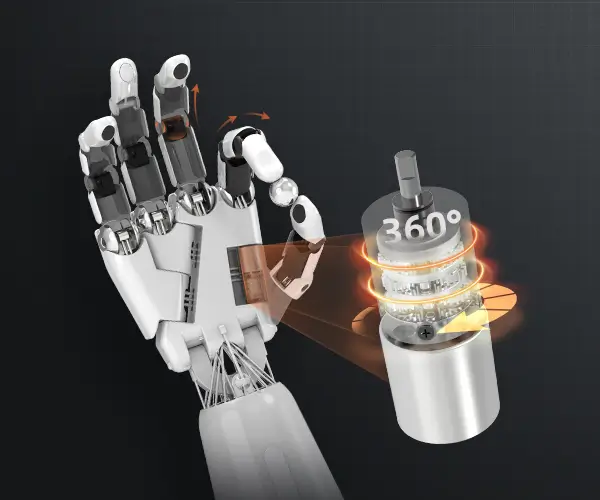Imagine a world where machines move with the precision and grace of a ballet dancer, responding intricately to commands and performing complex tasks effortlessly. This isn't just the stuff of science fiction; it's the reality made possible by servo motors. Widely used in robotics, remote-controlled vehicles, CNC machinery, and even camera autofocus systems, servo motors are the silent heroes behind countless innovations.

But have you ever wondered how these tiny yet powerful marvels work? More intriguing still: how to craft a servo motor of your own, tailored to your specific needs? Building a servo motor might seem like a daunting task reserved for industry experts, but with a good understanding of its core elements and a dash of curiosity, you can venture into creating your very own.
Let's embark on this journey by unraveling what makes a servo motor special. At its core, a servo motor combines a DC or AC motor—sometimes a stepper—with a sophisticated control system that lets it rotate to a precise position and hold steady. Unlike regular motors, which just spin unabated, a servo has a feedback mechanism that constantly checks its position and corrects any deviations, ensuring accuracy and stability.
The Heart of the Matter: Core Components of a Servo Motor
To understand how to make a servo motor, we need to dissect its essential parts. Here's what gives a servo its remarkable capabilities:
1. The Motor This is the core actuating component. It can be a small DC motor or a stepper motor designed for precise rotation. The motor's primary job is to generate movement based on control signals.
2. The Feedback Device Typically, a potentiometer or an encoder provides real-time information about the motor's position. This data acts as the "eye" of the system, guiding adjustments to maintain target positioning.
3. The Control Circuit A sophisticated circuit, often composed of a microcontroller or dedicated servo driver, processes signals from the input (like a command to move to a certain angle) and feedback data, then sends appropriate signals to the motor.
4. The Gearbox Many servo motors include gears to amplify torque and refine movement precision. These gears translate the motor's rotary motion into controlled, accurate movement.
5. Power Supply Adequate voltage and current are vital for smooth operation. Depending on the design, a servo can run from simple batteries or more complex power supplies.
From Concept to Creation: Steps to Build Your Own Servo Motor
While manufacturing a professional-grade servo motor is a complex process, you can assemble a DIY version that demonstrates the mechanics and principles. Here's a roadmap:
Step 1: Gather Components
Small DC motor or stepper motor Feedback device (potentiometer or optical encoder) Microcontroller (like Arduino or ESP32) Motor driver module (L298N, L293D, or similar) Gears (plastic or metal gear train) Power source (battery pack or power supply) Connecting wires, breadboard or PCB for connections
Step 2: Assemble the Mechanical Parts Mount the motor onto a sturdy frame. Attach the gearbox if available. Connect the feedback device directly to the motor shaft or via gearing so that it accurately reflects the motor's position.
Step 3: Set Up the Control Circuitry Wire the motor to the driver module, then connect this to your microcontroller. Integrate the feedback device so that it can send position data back to the microcontroller in real time.
Step 4: Program the Control Logic Using coding platforms like Arduino IDE, write a control loop that reads the feedback device, compares its value to a target position, and adjusts the motor power accordingly. Implement a proportional-integral-derivative (PID) control algorithm for smooth, precise motion.
Step 5: Power Up and Test Supply power to your circuit. Send commands to move the servo to specific positions and observe how well it holds or reaches the target. Fine-tune your code and mechanical connections as needed.
Tips and Tricks for a Successful DIY Servo
Choose the right components: For beginner projects, small DC motors with integrated gearboxes are readily available and easy to work with. Check calibration: Ensure your feedback device accurately reflects the motor position; misalignments can cause control issues. Implement safety features: Include current limiting and thermal protection to prevent damage during testing. Start simple: Focus initially on achieving basic position control before moving onto complex applications.
Why Build Your Own Servo?
Creating your own servo motor isn't just a fun project—it's an educational experience that deepens your understanding of electromechanical systems. It opens the door to customized solutions where off-the-shelf motors might not fit perfectly. Whether you're a hobbyist eager to tinker or an engineer exploring new designs, building a basic servo can be a rewarding endeavor.
In the next part, we'll explore more advanced techniques, materials, and troubleshooting tips to refine your homemade servo motor, transforming it from a simple prototype into a reliable component for your projects. Stay tuned as we dive deeper into the fascinating world of motion control!
Kpower has delivered professional drive system solutions to over 500 enterprise clients globally with products covering various fields such as Smart Home Systems, Automatic Electronics, Robotics, Precision Agriculture, Drones, and Industrial Automation.




































